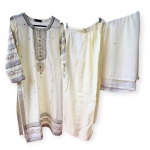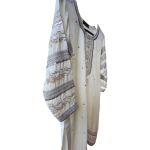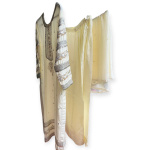Silk fabric, metal, raishum thread, and beads are elements that come together to create exquisite and luxurious textiles. From elegant silk pants to a delicately finished chiffon dupatta, these materials add a touch of sophistication and timeless beauty to any wardrobe. In this article, we’ll delve into the world of silk fabric, explore the significance of metal, raishum thread, and beads in textile design, and offer insights into styling and caring for these beautiful garments.
History of Silk Fabric
Origins of Silk
Silk has a rich history that dates back thousands of years. Originating in ancient China, it was first discovered by the Empress Leizu. According to legend, she found silk when a silkworm cocoon fell into her tea, unraveling to reveal the shimmering thread. This serendipitous discovery led to the cultivation of silk and the establishment of the Silk Road, which connected the East and West, facilitating the trade of this precious fabric.
Evolution through Centuries
Over the centuries, silk production techniques evolved, spreading to different parts of the world. Ancient civilizations like India, Persia, and Rome developed their own methods of silk weaving and embroidery. Each region added its unique touch, creating a diverse range of silk textiles that reflected their cultural heritage.
Silk in Modern Times
Today, silk remains a symbol of luxury and elegance. Modern advancements have made it more accessible, yet it retains its prestigious status. From high fashion runways to traditional attires, silk continues to be a favored choice for designers and consumers alike.
Characteristics of Silk Fabric
Natural Luster
One of the most captivating features of silk is its natural luster. The way it reflects light gives it a unique sheen that other fabrics simply cannot match. This luster is due to the triangular prism-like structure of the silk fiber, which allows it to refract light at various angles.
Smooth Texture
Silk is renowned for its smooth, soft texture. This makes it incredibly comfortable to wear and gentle on the skin. Unlike many synthetic fabrics, silk does not cause irritation, making it a popular choice for those with sensitive skin.
Durability
Despite its delicate appearance, silk is surprisingly strong and durable. Its tensile strength is comparable to that of steel, making it a reliable fabric for various applications. With proper care, silk garments can last for many years, maintaining their beauty and quality.
Types of Silk Fabrics
Mulberry Silk
Mulberry silk is the most common and highest quality silk available. It comes from the Bombyx mori silkworm, which feeds exclusively on mulberry leaves. This type of silk is known for its fine texture and uniform color.
Tussar Silk
Tussar silk, also known as wild silk, is produced by silkworms that feed on oak and juniper leaves. It has a unique texture and natural golden hue, which makes it highly prized for traditional garments and saris.
Eri Silk
Eri silk, also known as peace silk, is produced without harming the silkworms. The open-ended cocoons allow the moth to emerge before the silk is harvested. This eco-friendly silk is soft, durable, and has a wool-like texture.
Muga Silk
Muga silk is a rare and luxurious silk native to Assam, India. It is known for its natural golden color, which becomes more lustrous with each wash. Muga silk is often used in traditional Assamese attire.
Metal in Silk Fabrics
Historical Use
The use of metal in textiles dates back to ancient times. Gold and silver threads were often woven into fabrics to create opulent garments for royalty and the elite. These threads added not only visual appeal but also a sense of grandeur and prestige.
Modern Applications
Today, metal threads are used in both traditional and contemporary designs. They add a touch of shimmer and elegance to garments, making them stand out. Designers use metal threads to create intricate patterns and embellishments that elevate the overall look of the fabric.
Benefits and Drawbacks
While metal threads enhance the aesthetic appeal of silk fabrics, they can also make the fabric heavier and less flexible. Additionally, these threads require careful handling to prevent tarnishing and maintain their shine.
Raishum Thread in Silk Fabrics
What is Raishum Thread
Raishum thread, also known as Resham thread, is a type of silk thread used for embroidery and weaving. It is prized for its strength, smoothness, and ability to hold vibrant colors. This makes it ideal for intricate designs and detailed work on silk fabrics.
How It’s Made
Raishum thread is made from high-quality silk fibers that are spun into fine threads. These threads are then dyed in a variety of colors, ready to be woven into fabrics or used for embroidery. The process requires skill and precision to ensure the threads are uniform and durable.
Uses in Silk Fabrics
Raishum thread is commonly used in traditional Indian garments such as saris, lehengas, and salwar kameez. It is also popular in contemporary fashion for creating detailed embroidery and patterns on silk fabrics, adding a touch of elegance and refinement.
Beads in Silk Fabrics
Types of Beads Used
Beads come in various shapes, sizes, and materials. Glass, crystal, metal, and plastic beads are commonly used in silk fabrics. Each type of bead offers a different look and feel, allowing designers to create diverse and intricate designs.
Techniques for Beading
Beading on silk fabrics requires meticulous craftsmanship. Techniques such as hand-sewing, loom weaving, and embroidery are used to attach beads to the fabric. These techniques ensure that the beads are securely fastened and enhance the overall design.
Enhancing Silk with Beads
Beads add dimension and texture to silk fabrics. They can create eye-catching patterns and embellishments that make garments more visually appealing. Whether used sparingly or lavishly, beads can transform a simple silk fabric into a work of art.
Silk Pants: A Fusion of Comfort and Style
Why Choose Silk Pants
Silk pants offer a perfect blend of comfort and style. They are lightweight, breathable, and drape beautifully, making them an excellent choice for both casual and formal wear. The natural properties of silk ensure that these pants keep you cool in summer and warm in winter.
Styling Tips
Silk pants can be dressed up or down depending on the occasion. Pair them with a simple blouse for a chic, everyday look, or add a tailored jacket for a more sophisticated ensemble. Accessories such as belts and jewelry can further enhance the outfit.
Care Instructions
To maintain the beauty of silk pants, it’s essential to follow proper care instructions. Hand wash or dry clean the pants to prevent damage to the fabric. Store them in a cool, dry place and avoid direct sunlight to preserve their color and sheen.
Chiffon Dupatta with Finished Edges
What is Chiffon
Chiffon is a lightweight, sheer fabric made from silk or synthetic fibers. It is known for its soft drape and delicate appearance, making it a popular choice for dupattas, scarves, and evening gowns.
Benefits of Finished Edges
A chiffon dupatta with finished edges not only looks more polished but also lasts longer. The finished edges prevent fraying and give the dupatta a neat, refined look. This adds to the overall elegance and durability of the garment.
Styling the Chiffon Dupatta
A chiffon dupatta can be styled in numerous ways. Drape it over your shoulders for a traditional look, or wrap it around your neck like a scarf for a modern twist. The lightweight nature of chiffon makes it easy to experiment with different styles and drapes.
Conclusion
Silk fabric, with its timeless beauty and versatility, continues to captivate and inspire. The incorporation of metal, raishum thread, and beads adds a unique touch to silk garments, enhancing their elegance and appeal. From the comfort of silk pants to the grace of a chiffon dupatta with finished edges, these textiles offer endless possibilities for fashion and self-expression.
FAQs
Q: How do I care for my silk garments? A: Hand washing in cold water with mild detergent or dry cleaning is recommended. Avoid direct sunlight and store in a cool, dry place.
Q: What makes raishum thread special? A: Raishum thread is known for its strength, smoothness, and ability to hold vibrant colors, making it ideal for intricate embroidery.
Q: Can metal threads tarnish over time? A: Yes, metal threads can tarnish if not cared for properly. Store garments with metal threads in a cool, dry place and avoid exposure to moisture.
Q: How do I prevent my chiffon dupatta from fraying? A: Choose a chiffon dupatta with finished edges to prevent fraying and extend the life of the garment.
Q: Are silk pants suitable for all seasons? A: Yes, silk pants are suitable for all seasons. They are breathable and comfortable in summer and provide warmth in winter.
























Reviews
There are no reviews yet.